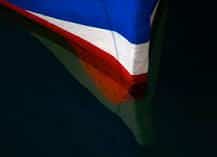 The French word quille came into our language as keel . The term is used with reference to a piece used in boats to seat the frame .
The French word quille came into our language as keel . The term is used with reference to a piece used in boats to seat the frame .
The keel, which can be made of iron or wood , is located in the lower sector of the ship. It is considered a key structural element, since it plays a role analogous to that of the spinal column .
The frames , which are the ribs installed along the length of the boat , are inserted into the keel. At the stern it is linked to the sternpost , while at the bow it is linked to the stem .
The keel performs a double function on sailboats by adding ballast and balancing the influence that the wind exerts on the sails. If the boat is very large, on the other hand, it is common for the keel to have two pieces (one horizontal and one vertical).
For zoology , the keel is the part that protrudes from the sternum of a bird . This is a sharp area that becomes more developed in species that fly at high altitudes or that travel long distances.
There is also another use for the keel in the field of zoology . The concept may refer to the protruding sections of the tail of certain fish .
In Inca mythology , meanwhile, Mama Quilla is a divinity. Mama Quilla can also be written all together, Mamaquilla. The expression, which can be translated into Spanish as Mother Moon , refers to the wife of Inti (son of Mama Cocha and Viracocha ) and mother of Mama Ocllo and Manco Cápac , brothers and husbands who founded the empire of this civilization according to the legend. In this case, it is estimated that the term keel
 With respect to Inca mythology , we can say that it is the universe that brings together the collective memory and legends of the Empire of the Children of the Sun that developed in what we know today as Ecuador, Colombia, Bolivia, Peru, Argentina and Chili. The success of this mythology was due to the military, commercial and political influence, in times prior to the conquest of the south and north of the Peruvian city of Cuzco, where the empire was born some time later.
With respect to Inca mythology , we can say that it is the universe that brings together the collective memory and legends of the Empire of the Children of the Sun that developed in what we know today as Ecuador, Colombia, Bolivia, Peru, Argentina and Chili. The success of this mythology was due to the military, commercial and political influence, in times prior to the conquest of the south and north of the Peruvian city of Cuzco, where the empire was born some time later.
The Inca religion, a framework in which the divinity Mama Quilla also fits, includes a series of rites and beliefs that were related to a biological system that evolved from before the Empire to its peak. It is worth mentioning that we can refer to the Inca empire through the term Tahuantisuyo , which means "four regions." The faith of his people could be seen in all aspects of their lives, from their work to their ceremonies and festivities.
Since the religion in the Inca Empire was polytheistic, their beliefs included several divinities, among which was Mama Quilla, the goddess of the menstrual cycle and marriage, in addition to being the mother of the firmament , a protector of women and having a very important role in the calendar, particularly for indicating harvest times. In the heavenly court, her rank was equal to that of her husband.
There are various myths that have Mama Quilla as the protagonist. For example, it was believed that lunar eclipses occurred because she was being attacked and that her tears were silver. Various very devout priestesses gathered in her temples, as well as numerous women who worshiped her with fidelity and fervor. She was the only one who could understand their desires and protect them from their worst fears. There were abundant objects made of silver , a material that the Incas related to the Moon.
